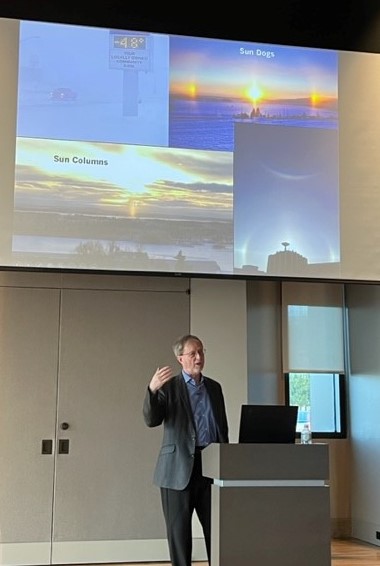Campus News
March 28th, 2023
Geophysical wonderland
Alaska's unique environment perfect for UA-F's Geophysical Institute

Dr. Robert McCoy, director of the Geophysical Institute at the University of Alaska-Fairbanks, was the latest presenter in the Joan Crawford Lecture Series Monday night at the Performing Arts Center at Garrett College
Alaska is a geophysical wonderland.
That was one of the takeaways from Monday night's Joan Crawford Lecture Series presentation by Dr. Robert McCoy, who serves as director of the Geophysical Institute at the University of Alaska-Fairbanks. The state has 54 active volcanoes, averages 50,000 earthquakes annually, and features 30,000 glaciers, 46,000 miles of coastline, and one million square miles of sea ice.
Alaska is certainly unique, says McCoy, who has spent his last 11 years as the Geophysical Institute's director.
"Often I look out my bathroom window and see that the sky is green," said McCoy explaining the strong solar activity that can generate a green glowing aurora over Alaska's night sky. "Ninety percent of Alaska is permafrost. There's an average of one earthquake every 10 minutes. Alaska is different."
Alaska's size also makes the 49th state – admitted to the Union almost eight months before Hawaii in 1959 – stand out.
"I'm a Texan," said McCoy. "I often joke, if you cut Alaska in half, Texas would be the third-largest state. There are actually national parks in Alaska that are bigger than Massachusetts."
Alaska's uniqueness even impacts the celebration of national holidays.
"There are no fireworks on the Fourth of July – because it's not dark," said McCoy, noting that Fairbanks' summer includes sun up to 24 hours a day. "We have fireworks in January." McCoy said moving to Alaska wasn't even a thought until the director's position at the Geophysical Institute became available.
"I'm in a local cabin at Deep Creek Lake retired – and then moved to Alaska," observed McCoy, adding in understatement, "There was a lot to get used to."
Fairbanks' winter weather, which seldom reaches 32 degrees, also creates some interesting school operations issues.
"It can be 60 below [zero] and the schools won't close," said McCoy. "But if it gets above freezing, they will close schools because the snow turns to ice."
Many of Fairbanks' unique features made UA-Fairbanks the perfect spot for the Geophysical Institute.
The institute – established in 1946 and tasked with maintenance of geophysical research concerning the arctic regions – has approximately 400 employees. About a quarter of them have doctorates, including 70 faculty members and 30 researchers. The institute includes seven research groups, nine major operational programs, and 10 other facilities with an $87 million annual budget.
The institute's mission most recently expanded in 2018 when it became a Department of Defense (DoD) University-Affiliated Research Center for geophysical detection of nuclear proliferation.
The Geophysical Institute manages numerous operational facilities, including the Alaska Volcano Observatory, the Alaska Earthquake Center, the Arctic Regional Supercomputing Center, and the Alaska Center for Unmanned Aircraft Systems Integration.
McCoy received his A.B. in Physics from Cornell University. He went on to earn his M.S. in Physics from Texas A&M, and his Ph.D. in Astro-Geophysics from the University of Colorado.
A former Army officer, McCoy led a team of scientists and engineers in building two dozen flight-related instruments on sounding rockets, the Space Shuttle, and experimental and Department of Defense operational satellite platforms.
Garrett College's faculty created the Joan Crawford Lecture Series in honor of the dynamic educator Joan R. Crawford.
Crawford, who died in 2010, served the College community for more than 30 years, including serving as the head of the humanities division and director of enrollment. After her retirement, Crawford was named Professor Emerita.
The Joan Crawford Lecture Series of presentations are offered free of charge, and the public and community members are invited to attend.
All presentations from the Joan Crawford Lecture Series will be available to view online through the College's Facebook page. The lectures will be live streamed and recordings will be posted shortly after the event.
.





